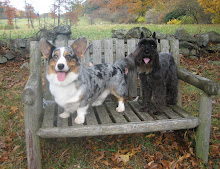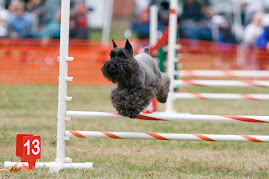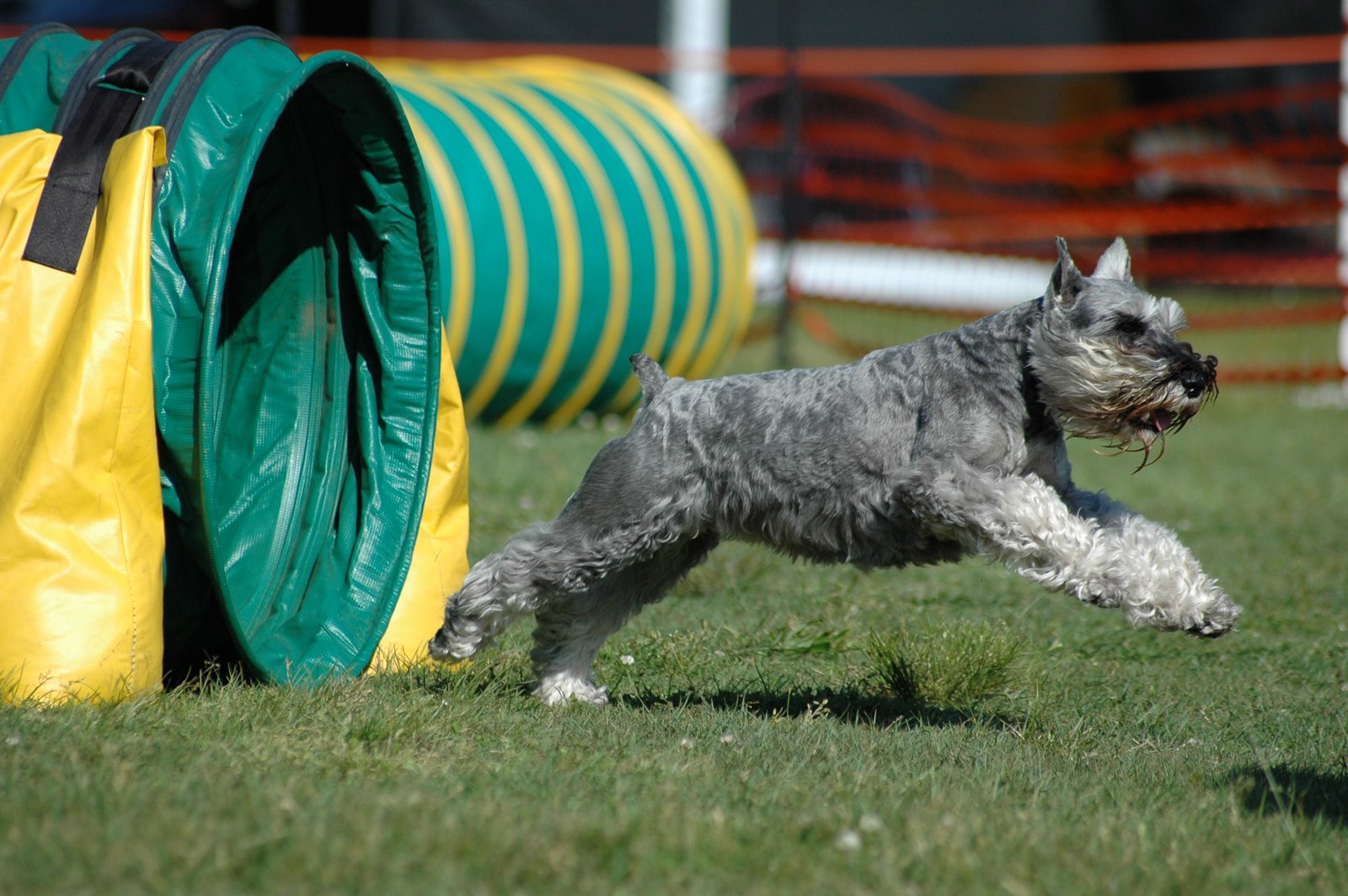Saturday afternoon Bug and I attended a Massage seminar at Masterpeace. It was taught by Julie Robitaille, CAMT.
I signed up for this seminar because I want to be as proactive with Bug’s structure as is possible. For example, when Bug’s sacrum is out and then adjusted he displays noticeable sensitivity in his back; it is tender. I want to know how to be able to help him recover quickly. When we saw Debbie Gross Saunders, she commented on his right side (the side with mild HD) being tighter. I am more than happy to spend the money on a professional occasionally, but I want the basic skills to be able to maintain and help my boy myself, too.
Julie is a graduate of Bancroft School of Massage Therapy in Worcester. She did her internship at Sterling Animal Impressions Rehab in Walpole, MA. Her specialty is Swedish Therapeutic Massage. The first portion of the seminar our dogs were crated and Julie’s goals were:
- Learn what massage is;
- Massage history;
- Why it benefits dogs;
- Common positions;
- Body language;
- Body mechanics.
What I expected when I signed up for this seminar was a primer on massage. I did get that in a very digestible manner. What I did not expect is, in a way, what the seminar was really about – helping reactive dogs. Huh? I knew Emma Parsons co-teaching the seminar and I wondered why.
Julie and Emma are co-writing a book that is due out in the spring of 2010. It is about a new modality Julie unintentionally (at least in the beginning) created which she is calling TACT: Touch Associated Clicker Training. The concept is that relaxation is a behavior and we need to find a way to capture that feeling/moment and put it on cue.
Having a reactive dog, who has been stuck on the “I saw a creepy person, didn’t react, please pay me” plateau for a few years – this is a really interesting concept. Julie has a reactive dog herself and large portions of her clientele are reactive dogs. What she saw as she worked on these dogs (these dogs that their humans didn’t think were capable tolerating touch from a stranger) is that the massage helped relax them in their everyday life.
Julie assists Emma with her reactive dog class and they talked not only about the need to write a book about this but taking it to the next level – giving the dogs the key to being able to tap into this relaxed feeling on cue.
More on all this later, for now – more massage info.
Massage is the manipulation of soft tissue to create a therapeutic response in the body.
Massage was developed in Europe and brought to the U.S. in the 60’s. In Europe it is commonplace for massage to be utilized in hospital settings.
After extreme, vigorous exercise, 5 minutes of massage will give you the same response as 1 hour of relaxation. (Research supported.)
Tense muscles (either knots in shorter muscles or ropes in longer muscles) are much more likely to be hurt. Unlike humans, dogs lack the ability to self massage. Julie believes that hot spots are likely an attempt to self-massage.
Benefits of Massage Therapy (these are scientifically proven not MT-proven):
- Strengthens the immune system.
- Decrease muscles soreness and stiffness.
- Relieves and reduces pain.
- Maintains tone and flexibility.
- Decrease blood pressure and heart rate.
- Increases comfort level of older dog.
- Builds trust and aids bonding.
- Enhances athletic performance.
- Increases circulation and blood flow.
- Stimulate and soothes the nervous system.
- Hastens muscle recovery.
- Reduces stress & anxiety.
- Assists in excreting toxins from the body – stimulates the lymphatic system (be sure to give your dog extra H2O to aid is excreting toxins after massage)
- Stimulates digestion.
- Increase range of motion and lengthening of muscles.
- Promotes all over well being.
- Drug free – only natural drugs produced by the brain!
Behavioral Benefits
- Physically relax body – changing dog’s perception on touch
Contra-Indications
When you should NOT massages dogs (Medical Association Guidelines)
- Cancer: Disease of lymphatic system – massage increases lymphatic circulation. “When in doubt, leave it out.”
- Acute Disc Disease: Primarily re bulging discs. With a bulging disc, muscles have tightened around the bulging disc to support it. A massage loosens the muscles holding the bulging disc in place causing a blown disc.
- Broken skin, trauma.
In addition Julie stressed a couple of key points:
This should be a POSITIVE experience for your dog. GO SLOWLY. No restraining. Watch YOUR body language and the DOG’s body language.
Body Mechanics – when giving a massage move your knees, your “breakpoints” and body in fluid motion. “Roll with it” versus only using your arms. Julie said you’ll end up broken in about 10 minutes if you only use your arms to give a massage.
Watch for “bad” body language: excessive head turning, yawning, licking lips, freezing. If spotted – SLOW DOWN.
Julie said that dandruff during a massage is the one instance in which a typical stress sign is not necessarily stress. During massage dandruff is frequently a result of increased circulation, pressure, and exfoliation.
Balance – you do not want a lopsided dog! If you massage one side – do the other.
On to the dog portion!
The first thing we worked on was creating our Comfort Conditioned Relaxation Mat. Julie recommends using the same mat for massage – each dog if you are in a multi-dog house – gets their own mat. The mat ONLY comes out when you are doing massage. Eventually if you bring this mat to a more exciting location you’ll should be able to give your dog a brief massage and quickly evoke a relaxed feeling.
I have not taught Bug “Go to Mat.” I shaped it, much like we teach it at Maplewood. In less than 5 minutes Bug was offering a down on the mat consistently enough I could up my ante when he left his front paws hanging off. Sometimes he is just brilliant. Of course, as John pointed out, he does REALLY likes mats, blankets, dirty clothes….anything suitable for lying on.
The first thing we worked on is putting lying on side on cue (lateral left, lateral right). This is VERY helpful for vet office visits, which are already a stressful experience for many dogs.
Ask your dog for a down. Use a treat, moving it along the foreleg until you reach the elbow, and then slowly move up the shoulder. You teach this the same way you teach roll over except you click and treat when your dog is lying on his side. Bug was super about lying on his right side, but not so good about rolling on his left side. Perhaps compensating for the weaker right side? We will work on this.
The next thing we worked on was a quick stretch. Have your dog “down.” Use a treat to lure your dog’s head back to his rib cage. Do this on both sides. Bug’s hind end was rolling a bit and appeared to be doing most of the work. I asked Julie about it and she said he is probably not capable of stretching that far yet and to work up to it.
On to the Massage!
The first stroke Julie taught us is called Finger Petrissage. You use the pads of your finger tips (four fingers for large areas and large dogs, two fingers for smaller areas and small dogs). Place the pads of you fingers on your dog; apply a gentle amount of compression (pounds per inch dogs like less compression than humans – keep that in mind). While holding your compression you roll your finger pads in a circular motion. You gently release. Julie suggests keeping your fingers lightly upon the dog as you move to the next position. Finger Petrissage is used most commonly on the muscles of the skull, jaw, sides of neck, shoulders, around hips and thighs.
I found it a bit difficult to capture the rolling motion – I assume it comes with practice. I also caught myself applying too much pressure.
The next stroke we learned was Effleurage. This is a gliding stroke following the flow/direction of the fur. Using the whole palm for larger areas or fingers/thumb pads for small areas on small dogs, apply a gentle amount of compression (pressing down into the muscle tissue). While holding the compression gliding your palm or thumb pad along the body area then gently releasing your compression at the end. This stroke can be short and overlapping or long covering the whole length of the body. Julie recommended this stroke for muscles on the SIDES of the spine, rib muscles, ears from base to tip, down thigh muscles and pectoral muscles.
Web of the Hand Petrissage is a massage technique I use frequently without realizing it. Using the web between your index finger and your thumb, apply a gentle amount of compression gently grasping the tissue. While holding your compression Apply a lifting motion then release. This motion can be repeated for six set. It should be rhythmic and flowing. Use on the back of the neck, in front and behind the elbow and hind legs.
Palm Petrissage is the same premise as finger petrissage but you do the compression and roll with your palm instead of individual fingers.
Final stroke we learned was Vibration. Using your finger pads in a claw like position. Use all five fingers for larger body areas. Two fingers for smaller areas.
Apply a very light amount of compression, while holding your compression gently vibrate/shake your hand while continuing to hold the compression – us the compression and vibration while gliding your hand down the body area. You can use this stroke everywhere except bony prominence.
A few more things to remember:
LIGHT compression.
Avoid direct contact with bony prominences…..avoid any direct contact with the spinal column – ONLY massage the muscles on either side of the spine.
Watch your body mechanics and go SLOW.
To pull all that we have learned together into TACT, Julie suggested starting a massage with finger petrissage on your dog’s face/head. Move down the body using web of the hand petrissage. Then effleurage or palm petrissage on the body of your dog. When you have completed the massage strokes above and your dog is relaxed use some vibrational massage and c/t your dog for being this relaxed.
Julie suggested a word like “Nice” as your cue for relax. She originally though about using "Relax" but thought if an individual heard you cue "Relax" they might think there is a reason to worry about your dog and their body language might change causing a change in your dog’s response. "Nice" is a non-reactive word for humans.
Eventually if you opt to work this plan and take it on the road you will ALWAYS give your dog a bit of vibrational massage when you cue them with your word.
It was a huge amount of information to take in and I have probably not done it all justice.
I do feel like this is a good next step for me and Ike. Having read Click to Calm and attended one of Emma’s seminars, that book changed my life. I felt like Control Unleashed was a tremendous step forward along the same path. I feel like TACT presents an opportunity to take it beyond the “I saw a creepy person and didn‘t react. Please pay me.” It takes it beyond conditioning a dog to react a different way when presented with something creepy to having a preconditioned cue that CHANGES the way they are feeling. I definitely believe this is possible with work.
Julie took our e-mails for a follow-up seminar – possibly in a month, to see where we are and perhaps move forward to the next step. I can’t wait.






6 comments:
very cool! your notes are great!
Very informative! I must say, what you described of the massage techniques, it sounds very similar to TTouch, which I do a lot of with Strata. I'd love to go to one of these seminars and learn more.
Did she talk at all about massage for dogs that don't want to relax into it? I have really not had any luck massaging Tess. She tolerates chiro, and does enjoy being petted, but it's like she just does not see the benefit of standing/laying around while I work on her. It's like she'll juuust start to be relaxed... and then get up and go do something. :/
Hi Cat, Other than going slow and stopping shorter than you would like to....while they are still in the midst of being relaxed, no real suggestions for dogs who won't relax. But perhaps in the next seminar. Of course, all the dogs that were there were non-reactive and pretty darn relaxed. Bug took a nap!
Wow! Nice post Julie. Your such a good mum.
If I go to one of these seminars, I'll definitely take Strata. He turns into a stuffed animal when he's getting stretched or massaged... the polar opposite of Ms. Tessie, who only stands still for pre-run stretching on a strict "stay" cue!
Wow! That sounds like an outstanding seminar. Thank you for sharing your notes. :)
Post a Comment